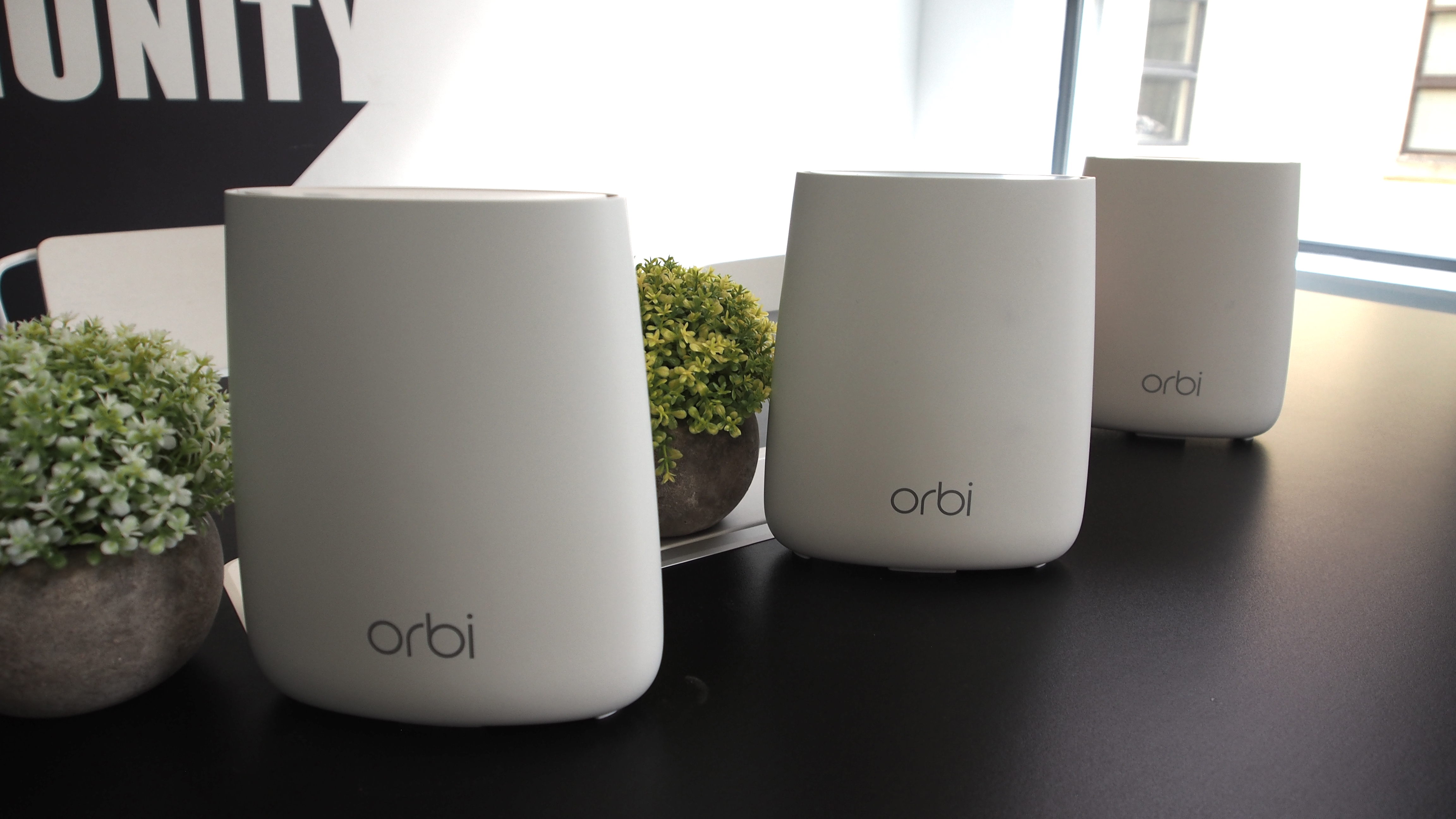TechRadar Verdict
The Netgear Orbi AC2200 RBK23 home networking kit is a great choice if you liked the look of the original Netgear Orbi but were put off by the high price and features you’d never use. This is a premium mesh Wi-Fi kit for smaller homes, and offers a build quality and user experience that other (admittedly less expensive) mesh Wi-Fi kits lack.
Pros
- +
Nice design
- +
Easy to set up
- +
Very good performance
- +
Lower price than original
Cons
- -
Still pricey
- -
Fewer Ethernet ports
- -
Simplistic documentation
Why you can trust TechRadar
The Orbi AC2200 RBK23 whole home Wi-Fi system is a smaller and more affordable take on Netgear’s original Orbi system. As Netgear is keen to stress, this isn't a sequel or replacement product; it's part of the same family, but aimed at a different market.
While the original Orbi system was designed to spread Wi-Fi far and wide in large houses while using some of Netgear’s cutting-edge technology, this wireless router is designed for more modestly-sized homes, with a few tweaks to the hardware that keep the price down; while the first Orbi system impressed us with its performance, it had a high price tag that was likely to put many potential buyers off.
The Netgear Orbi AC2200 RBK23 aims to offer a more affordable way to get the Orbi experience for people who don’t need all of the original Orbi’s high-end features. It’s a fine balance that Netgear is trying to achieve: reducing the cost of the Orbi by making some careful cost-cutting decisions, and without cutting too much.
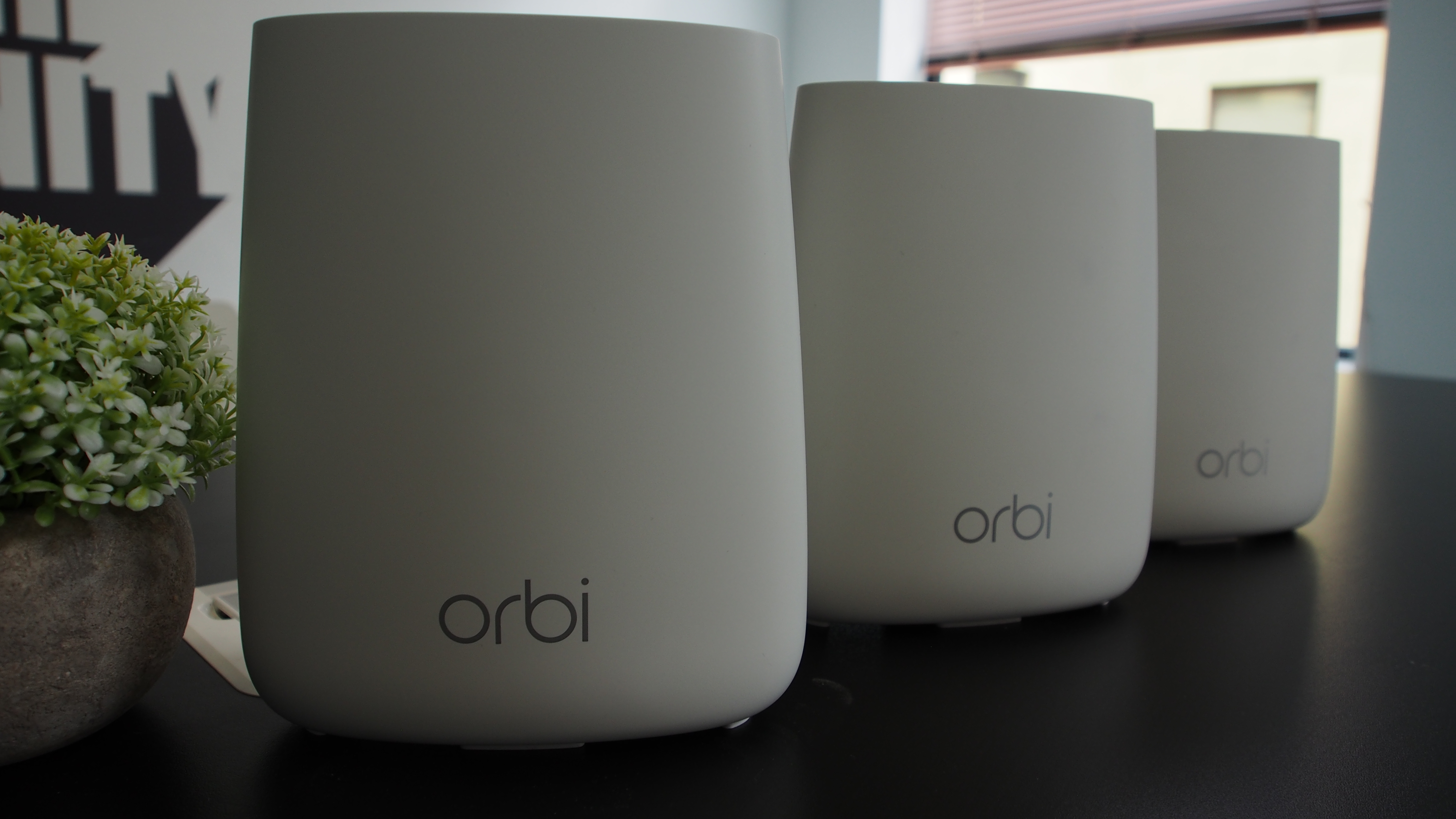
Price and availability
The Netgear Orbi AC2200 RBK23 costs $299 (£299, AU$499) for three units: one router and two satellites, with Netgear promising a coverage area of 6,000 square feet. It’s a clear saving on the original Orbi, which sells for $399 (£399, AU$749) and which comes with two units.
However, that’s still a pretty high price for a mesh-like router system (Netgear was keen to stress to us that the Orbi is not a mesh Wi-Fi system in the traditional sense). Google Wifi, for example, is our current pick for the best mesh Wi-Fi system, and it costs less at $279 / AU$499 for a setup with three modules, similar to the Netgear Orbi AC2200 RBK23 offering.
In the UK, you can get a Google Wifi set with two units for £229. Google’s reasoning is that homes in the UK are smaller, so more than two units will usually be overkill (although you can buy additional satellites).
Netgear does offer a two-unit set with a coverage area of 4,000 square feet, available in the US for $200 at Costco. This will also be available in the UK for £229.99 – the fact that this price is almost identical to Google Wifi is likely no coincidence.
While the Netgear Orbi AC2200 RBK23 offers a price that’s more competitive, it’s still a pricey proposition, and there are a growing number of mesh systems that will be competing with the new (and old) Orbi systems, which could make the high price harder to justify.
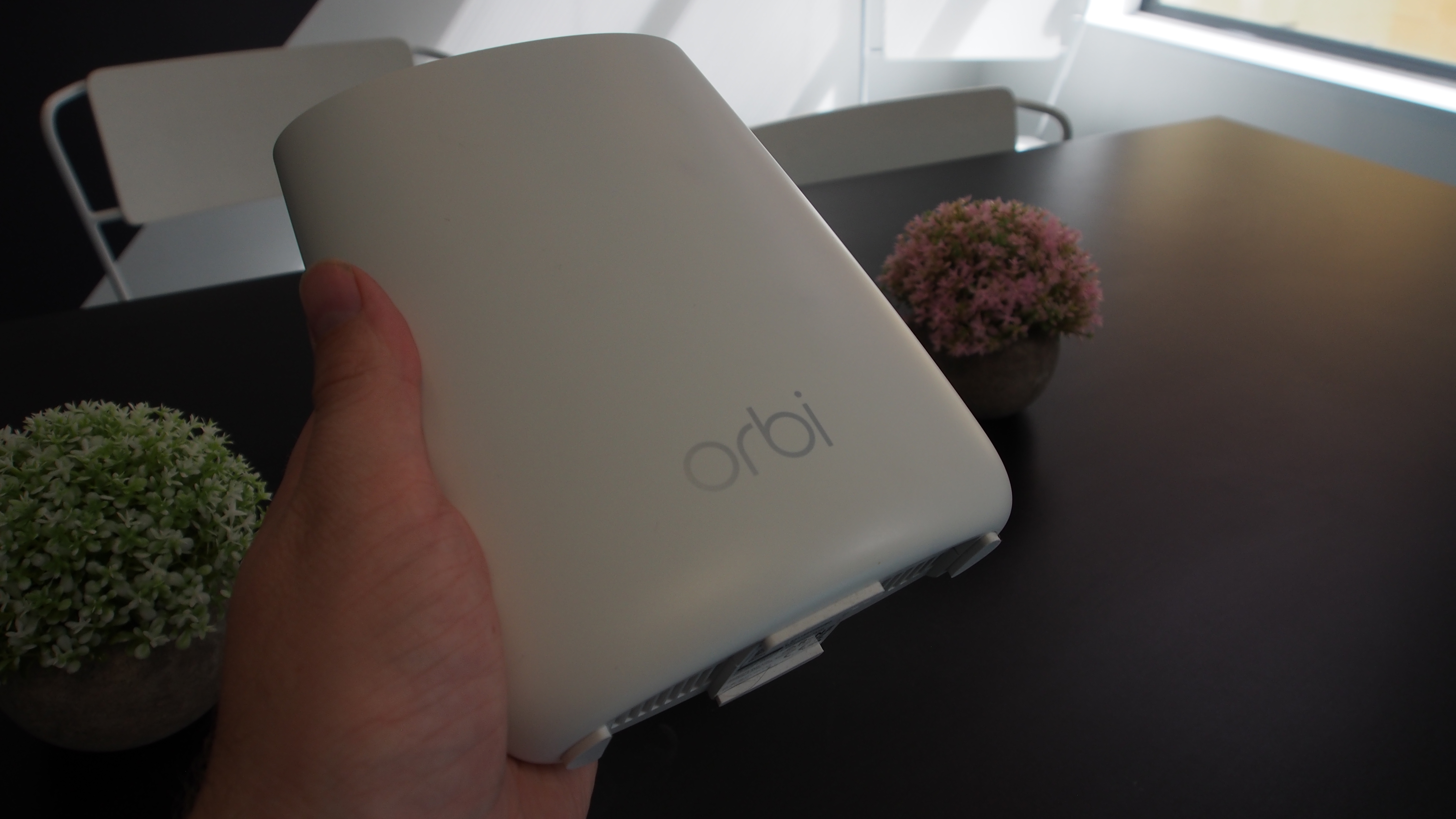
Wireless Connectivity: Smart Hub 2: IEEE 802.11b/g/n/ac, dual-band 2.4GHz and 5GHz, 2.4GHz 3x3 MIMO 11n, 5GHz 4x4 MIMO 11ac, DECT CATiq 2.1; Wi-Fi Disc: IEEE 802.11b/g/n/ac, dual-band 2.4GHz and 5GHz, 2.4GHz 4x4 MIMO 11n, 5GHz 4x4 MIMO 11ac)
Processor: Quad-core ARM CPU (each core up to 710MHz)
Memory: 512MB RAM
Storage: 256MB flash
Beamforming: Implicit and Explicit for 2.4 & 5GHz bands
Ports: 2 x Gigabit Ethernet ports per unit
Dimensions: 5.6 x 2.4 x 6.6 inches (142.4 x 60.9 x 167mm; D x H x W) each
Weight: 476g each
Design and setup
The design of the Netgear Orbi AC2200 RBK23 will be instantly recognizable to anyone who's familiar with the original Orbi, with the router and two satellites looking almost identical, but with different dimensions.
The original Orbi router and satellites each measured 6.67 x 2.36 x 8.89 inches, while the Orbi RBK23 units measure 5.6 x 2.4 x 6.6 inches. This makes for a far less intrusive router and satellite system, and the design certainly looks nicer when shrunk down; the larger white units of the original Orbi were a bit too big to place around the home without them looking out of place, while these smaller units can be tucked away without calling too much attention to themselves.
As with the original, the three units look the same at first glance, but the top of the router unit has a faint blue finish. Each unit has two Ethernet ports for wired connections, although one of the router’s Ethernet ports is highlighted yellow and is labelled 'Internet'. This is the port you connect your existing modem to.
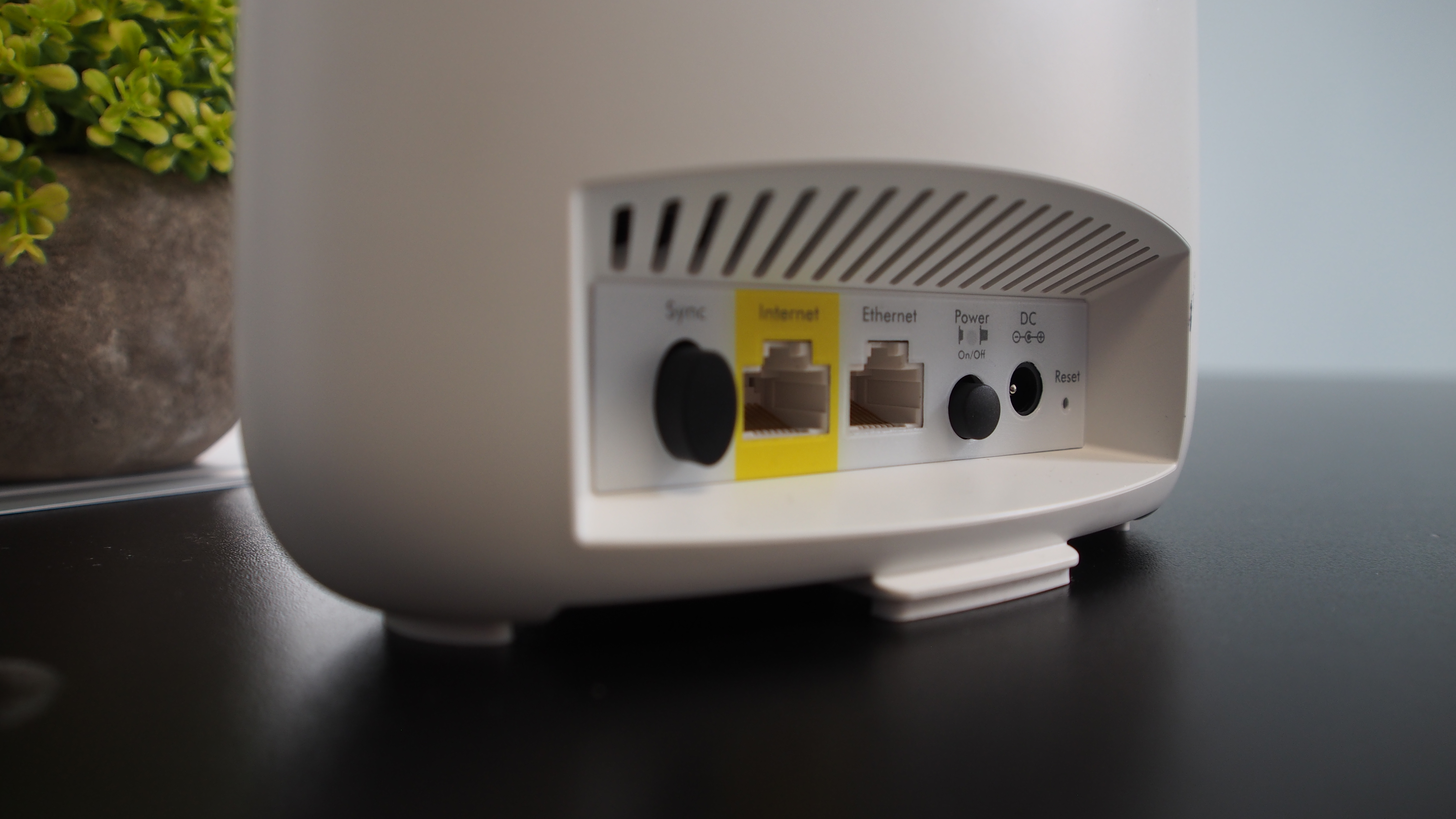
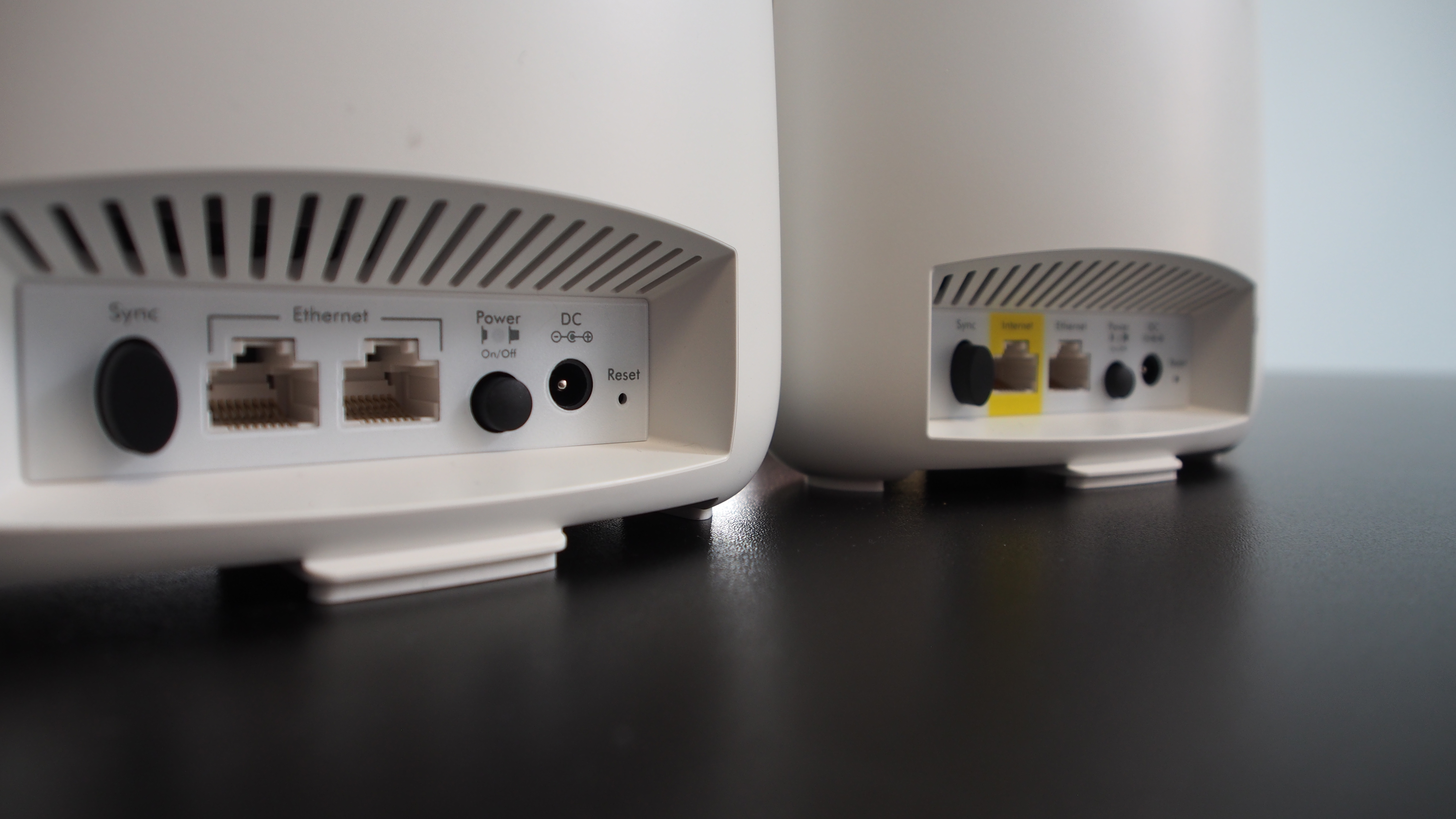
This means the router unit only has one spare Ethernet port for hooking up wired devices. The original Orbi system has four Ethernet ports for each satellite, and three Ethernet ports (and one reserved for connecting to the modem) on the router unit. If you have a lot of devices that still require wired internet connections, then this reduced connectivity may disappoint. However, by cutting the amount of Ethernet ports, Netgear has been able to reduce the size and price of the Netgear Orbi AC2200 RBK23, and for households that use predominately wireless devices, this will be a welcome move.
Another port that’s been ditched is the USB connection. In the original Orbi (and many other routers) a USB port was included for easily sharing files on a USB stick, or access to a printer.
It’s a nice feature to have, and its absence in the Netgear Orbi AC2200 RBK23 will be disappointing to some, but for many people the port would have rarely been used, and if that’s the case then the lack of the port will be a price worth paying for the lower cost of the router.
The shrunk-down size – both physical and when it comes to price – has led to reductions elsewhere. While the Netgear Orbi AC2200 RBK23 offers simultaneous Tri-band Wi-Fi, as the original Orbi does, it has four internal antennas, compared to the original’s six. Having the antennas housed internally in the body makes for a nicer-looking device, but can potentially limit the coverage compared to routers with external antenna, especially ones that can be positioned to point at various devices.
The antennas are capable of beamforming, however, which is a feature that cleverly detects the location of devices connected to the Wi-Fi, and aims the wireless network towards that location for better coverage.
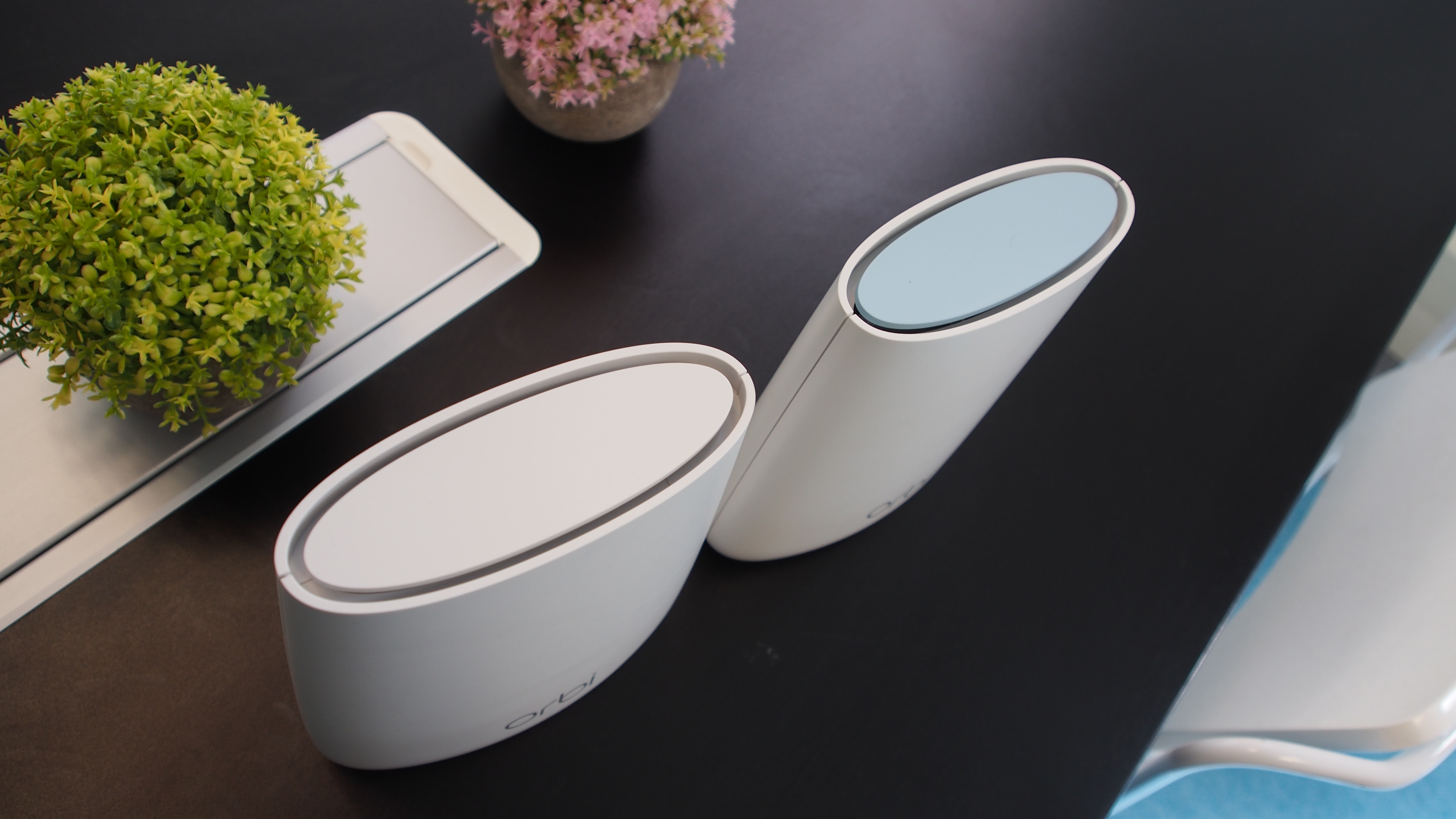
Overall, we think the design of the Orbi AC2200 RBK23 translates very well to the reduced size. In fact, we’d say it actually suits the smaller Orbi AC2200 RBK23 better than the original. The reduction in ports is understandable, in our view, as Netgear is aiming for a smaller, cheaper router that's designed to appeal to more casual users who won’t use many wired devices, or want to share USB kit between PCs connected to its home network. If you do miss those features, then Netgear’s belief is that you’d be better off putting down money for the original Orbi.
The straightforward setup of the original Orbi system carried over to the new system, so you get an attractive and easy-to-use app for your Android or iOS device, which takes you through the process of setting up the Orbi AC2200 RBK23. We plugged the router unit into our modem and followed the instructions. The app was clever enough to set the IP addresses the Orbi hands out to a number that won’t clash with the modem, which can often happen when you're installing a new router and allowing it to act as a DHCP (Dynamic Host Configuration Protocol) server.
This led to a rather painless setup for the router unit. Netgear is obviously confident that the setup procedure is straightforward, as the instructions it supplies, either in the form of the physical (and flimsy) manual that comes in the box, or through the app, are very basic. This can be an issue when it misses out an important bit of information, or when something goes wrong and you want to troubleshoot it, which happened to us.
This is because after installing the router unit, the app asked us if we wanted to install the updated firmware for the unit. We agreed to this, as we wanted to test the router with the most recent software installed. However, this was to cause unforeseen problems, and nowhere in the documentation were we warned about these.
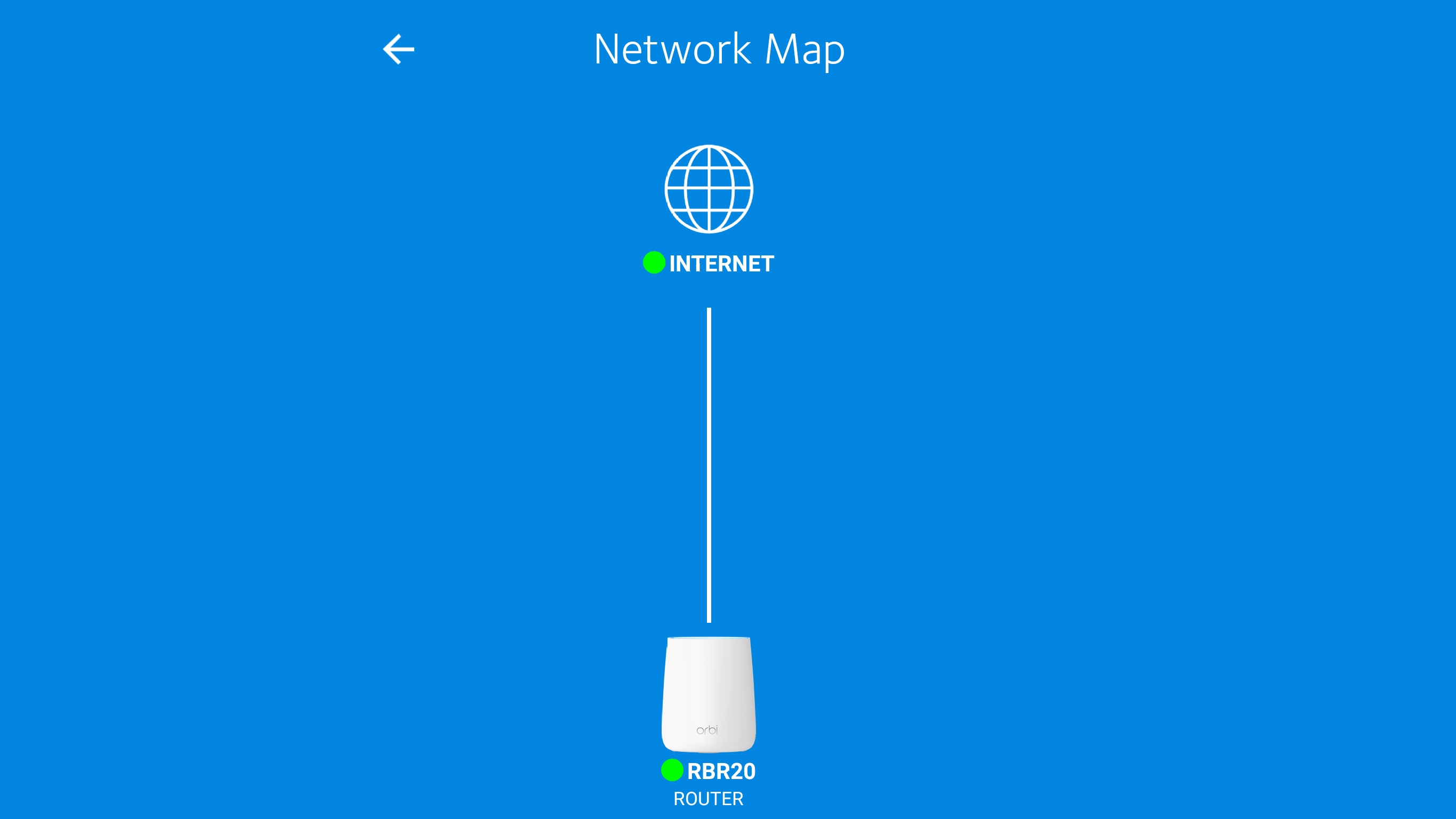
With the router unit set up and working well, we then went to add a satellite unit elsewhere in the building to help expand the W-Fi. This is accomplished in the same way satellites were added to the original Orbi: you plug in the satellite, press the 'Sync' button on the satellite, then press the same button on the router and let the units talk to each other; an LED light at the top of each unit lets you know when they'e connected. The process should be simple, but we hit a snag.
This was that the router unit just could not find the satellite. We moved the satellite unit closer, but no luck – even if they were in the same room, the two units wouldn't pair. We were perplexed, and checked the documentation – and this is where the lack of in-depth documentation caused an issue, as while the manual explains what color the LED lights change to if there's a problem, it does not say how to fix that problem.
We ended up searching the internet, and found a post on Netgear’s forums that provided the answer to our problems. It turns out that when the router firmware has been updated, it then can't find satellites whose firmware hasn't been updated – and you can't update the satellite firmware without it being connected to the router.
You need to connect the satellites, then update the satellite firmware first, before updating the router firmware, otherwise they won’t sync. So we had to reset the router to the factory defaults, set it up again, connect the satellites, then update the firmware. We did that and everything connected fine, but if there had been a warning about this in the manual or app it would have saved us time and energy spent fixing this issue.
With that problem solved, however, the rest of the setup procedure went well, and the well-made app helped us finish setting up the system. If you don’t have a compatible phone, you can use your PC to connect to and set up the Orbi AC2200 RBK23 system.
The setup procedure is definitely aimed at casual users, and is made as simple as possible. But while this is great when things work as they should, if you’re after more control over your router setup, or need information when things don’t go as planned, then you may end up frustrated.
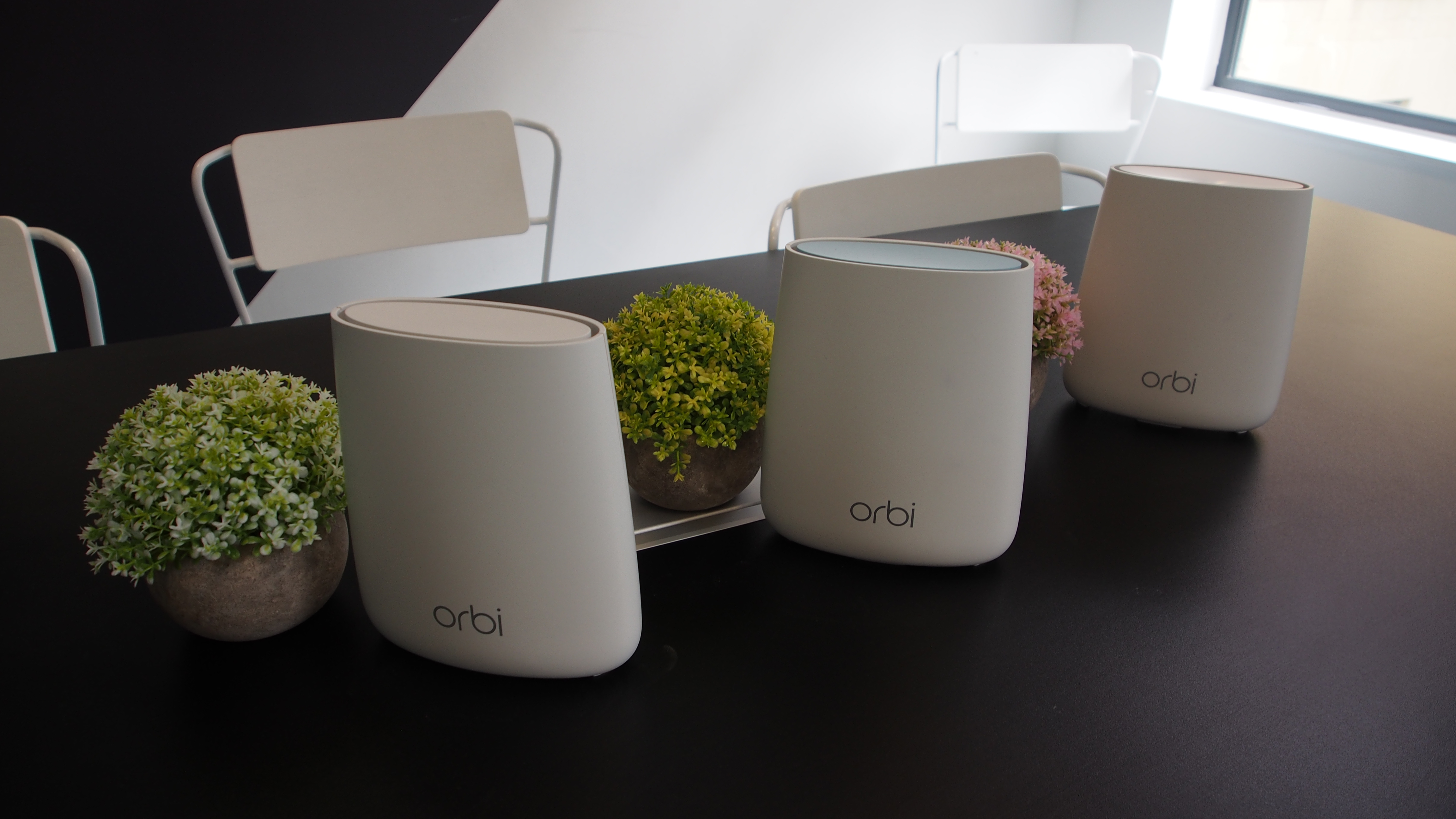
Here is how the Netgear Orbi AC2200 RBK23 fared in our brief suite of tests (conducted on a 70Mbps service):
Ookla Speed Test 5GHz (Download | Upload):
Within 5 feet/1.52 meters; no obstructions: 68.8 | 17.9 Mbps
Within 13 feet/9.14 meters; three plaster walls: 68.7 | 17.9 Mbps
Performance
While the number of antennas in the Netgear Orbi AC2200 RBK23 has been reduced compared to the original Orbi, so has the speed. While the original was capable of AC3000 throughput (1733 + 866 + 400Mbps), the new RBK23 is only AC2200 (866 + 866 + 400Mbps).
For busy wireless networks with a lot of traffic and high data throughput, this may be an issue, but for most modest home setups you may not notice, especially if you mainly use the Netgear Orbi AC2200 RBK23 for connecting to a standard home broadband connection, as most people’s speeds won’t be limited by AC2200.
The Orbi systems (both old and new) have a dedicated connection between the satellite and the router, and with the newer version this connection is slower. So, if you’re connecting wirelessly to the satellite, your network traffic is then going through a secondary wireless connection between satellite and router. As we mentioned, for regular internet browsing this probably won’t be an issue (unless you have a very fast connection) but streaming gameplay or moving large files around may have an impact.
However, we found that even one satellite, never mind two, may be superfluous unless you have a very large property. This is because the range of the Netgear Orbi AC2200 RBK23 is excellent on its own.
We tested it in a medium-sized property in the UK, with three floors, and with just the router unit plugged in we got excellent coverage throughout the building. As you can see from our test results, the internet speeds remained pretty consistent with our test device connected to the router in the same room, and on the top floor.
This is excellent coverage that beats many routers we’ve tried with external antennas. In fact, it’s so good the extra satellites weren’t needed. However, with them set up, it meant we had excellent coverage throughout the building, with our device seamlessly connecting to the nearest satellite.
Even in this pared-down form, many people will consider the Netgear Orbi AC2200 RBK23 overkill. However, if you have a very large property, or want the same Wi-Fi network to cover your entire property, then you’ll be impressed with this device.
It also handled our wired devices well, although we used a network switch due to the lack of ports on the unit. For people who mainly use Wi-Fi, this won’t be an issue.
Verdict
When companies bring out, cheaper, pared-down versions of their established products they need to carefully trim features without cutting too much, and the good news is in creating the Orbi AC2200 RBK23, Netgear has made some good decisions.
Cutting the number of Ethernet ports, and dropping the USB port altogether, are sacrifices that we don’t think the target user will mind making for a smaller form factor and lower price.
The cut in the number and speed of the antennas will have more of an impact, but again Netgear is positioning the Orbi AC2200 RBK23 as a solution for smaller households with less busy Wi-Fi networks.
And, as our tests showed, the Orbi AC2200 RBK23 remains powerful enough to give all but the largest properties fast coverage throughout – especially when you add the satellites in carefully-placed positions.
The Netgear Orbi AC2200 RBK23 kit is also aimed at people who want a quick and easy way to set up and expand their home Wi-Fi, and while this will appeal to many, if you want a more in-depth and powerful system for controlling all aspects of your home network then you'll feel frustrated by the simple nature of this system.
- Check out our Netgear promo codes to get the best deals on Netgear products.

Matt is TechRadar's Managing Editor for Core Tech, looking after computing and mobile technology. Having written for a number of publications such as PC Plus, PC Format, T3 and Linux Format, there's no aspect of technology that Matt isn't passionate about, especially computing and PC gaming. He’s personally reviewed and used most of the laptops in our best laptops guide - and since joining TechRadar in 2014, he's reviewed over 250 laptops and computing accessories personally.
